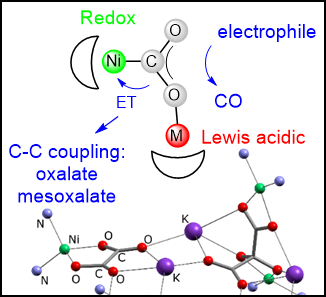Controlling CO2 activation and utilization of formate for value added productsThe research group of Christian Limberg has revealed that after activating CO2 at a reduced nickel center the contact with the second metal center is decisive for the proceedings. If the metal shows significant Lewis acidity the entity is primed for CO elimination in contact with an electrophile, if it is a weak acid, the positioning of the electrons can be shifted towards the metal, which opens up CO2.− chemistry and can thus be utilized for C-C coupling reactions. Furthermore, it has been shown that formate deprotonation can give rise to reduced CO2 species, just as the direct reduction of CO2 does. This makes formate an interesting, easier to handle synthon in corresponding conversions.
Steuerung von CO2-Aktivierung und Nutzung von Formiat zur Erzeugung von WertproduktenDie Arbeitsgruppe um Christian Limberg konnte aufzeigen, dass nach der Aktivierung von CO2 an einem reduzierten Nickel-Zentrum der Kontakt mit einem zweiten Metall-Zentrum den weiteren Verlauf der Reaktionen bestimmt. In Abhängigkeit von dessen Lewis-Acidität, wird die Einheit entweder empfänglich für den Angriff von Elektrophilen, die daraus dann CO freisetzen, oder ein Elektron verschiebt sich Richtung Metall-Zentrum, was dann CO2.− Chemie ermöglicht und für C-C-Kupplungsreaktionen genutzt werden kann. Zudem wurde gezeigt, dass die Deprotonierung von Formiat zu reduzierten CO2-Spezies führen kann, die mit denen, die im Zuge der CO2-Aktivierung entstehen, vergleichbar sind. Das macht Formiat zu einem interessanten, einfacher zu handhabenden Synthon in entsprechenden Umsetzungen.
"Selective transformation of Nickel-bound formate to CO or C-C coupling products triggered by deprotonation and steered by alkali metal ions"
|


